Video Transcription: Tiger Woods/Chuck Quinton FO
All right. I'm going to listen to all your requests on the forum to see a comparison of my golf swing to Tiger Woods' swing, and see where I'm at with the progress with RST, and see how that looks compared to Tiger Woods' golf swing, and how far I've got to go.

Tiger Woods & Chuck Quinton
I've got a swing up here of me on the right, and of course Tiger Woods on the left. Unfortunately, this video doesn't go to setup, but that's as close as we're going to get. It's just during the takeaway.

Setup - Left ear on the ball
A few things you're going to notice here; one, that the camera angle is a little bit different.
In one the photographer is a little bit more in front of him, so it's going to make the ball look a little bit farther back in his stance, and it's also lower than mine.
You'll notice from this angle, because the camera is looking more down on me, the camera is set higher, the ball looks like it's farther below my feet, whereas his looks pretty level, so note that.
There's a couple of things that you'll notice, especially when we get to the top of the golf swing, it'll alter a couple of things. Anyway, here we go.
At setup, a couple of basic things that I'll talk about real quick here. The left side of the ear is about where the ball is, nothing special there.
One thing I continue to struggle with - or just get lazy with, I should say - is my stance width.
I have really narrow hips, and I tend to get my stance too wide, so even though my stance probably looks pretty narrow there - this is a 5 iron, by the way - it's not. For my hip size, you can see that my foot is definitely more than two inches outside of there.
The left one's pretty close, but still a little wide.
If we draw a line on Tiger Woods, you'll notice - again, the camera angles are a little bit off here, but you can get a pretty good idea that he tends to stand pretty close to following the two inches outside of neutral, based on his hips, but pretty similar, in terms of setup there.

Tiger's stance is about 2" outside neutral - Chuck's is too wide for his hip size
As we start the club back, one of the things that I've worked on a lot is to not snatch it back with my right hand - doing the shoulder blade glide, using my obliques and torso muscles to rotate my body, rather than just swinging my arm across - but I used to get my right hand really on top of the club here, so that the logo on my glove would be more or less facing the ground.
That's a little bit of an exaggeration, but that's the feeling that it would create.
I would end up with a little bit of a shut club face at the point in the swing when the takeaway is done, when the club is about parallel to the ground.
You can see Tiger Woods definitely gets the logo of the glove working out, away from him. There's a little bit of rotation in that left forearm.
The reason I mention this is that I see so many amateurs who hinge that right wrist early.
When they hinge the right wrist, the next thing to go is they tend to bend the right elbow. What this tends to do is, it moves the golf club a long ways.
If you take this joint, your right wrist joint, and just hinge it straight back, you're going to move the club a couple feet and shut the club face.

Comparing the takeaway
That's something I see all the time, and that's really typical.
When people don't make a full shoulder turn, they tend to hinge the club to get it to a set position with that right wrist. They do it very early and it throws the entire golf swing off.
I used to do it to a little degree, but I've worked hard to get the logo of the glove a little bit more out as I'm rotating, than having a tendency to get my right wrist hinged.
This is basically just keeping my arms in neutral, but for me it feels like I have to work to do it, a little bit.
At this point, not a whole lot of differences.
Obviously, Tiger Woods is going to be a little bit steeper with his shoulders, for the simple fact that he's quite a bit taller, and probably using a little bit of a shorter club here than I'm using, but not a whole lot of differences here.
Takeaway, obviously, is something that it's pretty easy to master if you follow the Takeaway Drill and the "5 Minutes to Rotation," and those things.
If you do that, you can get into a very similar position to Tiger Woods, as I am here, without a whole lot of work.
As we keep going back, the next area that we'll check is when the left arm is parallel to the ground.
The big thing that I look for here is that the golfer has a lot of rotation and almost a full 90 degree shoulder turn at the point where the left arm is parallel to the ground. I'm pretty close here.

Comparing shoulder turn - also note straight left leg
We look at Tiger Woods' swing, again the camera angle is a little forward so it's going to make him look like he has a little more rotation, but pretty close here.
You're starting to see the back of his shirt, the back of his right shoulder, and that right shoulder has disappeared behind his head.
Technically, I could probably have a little bit more rotation at this point.
It's something I'm probably getting a little bit lazy with there, but more out of the fact that I'm working so much on some things in the downswing - I can't balance more than one thought in my head, so I'm not really focusing on making sure I make a good turn.
It's probably something I need to go back to, to make sure that that doesn't get too lazy.
You'll see pretty similar positions in terms of the club and the arms, and not a whole lot of difference. The big thing here, again my stance width is just a little bit too wide, so that's one thing that will look a little bit different.

Chuck's leg is straight - the red line shows what left side breakdown would look like
Notice in terms of hip rotation, there's not a whole lot of hip rotation. I have about the same amount of space between my knees that I started out with. You can see the same thing in Tiger Woods' swing.
You want to maintain that spacing there.
I see a lot of golfers who, at this point in the golf swing, would have an angle where, from the hip to the knee would go this way, and then that way.
That's that left-side breakdown. If you go back to some of the Rotary Swing videos, I talked about left side breakdown.
That's what's happening, and that's what's allowing the hip to over-rotate, making it really hard to get back to the left side on the downswing.
At this point you want to pretty much be able to draw a line straight from the center of the hip, center of the knee, center of the ankle.
You can basically see that on both Tiger Woods and myself, here. Not a whole lot different at that point.
As we keep going, we're starting the right elbow flexion at this point. We've had some shoulder elevation.
One thing that I've got to make sure of, for most golfers, is that once they start to add that right elbow flexion that they don't just stop turning. At this point I'm still creating that last little bit of dynamic stretch, because my hips are getting ready to go back the other way, but my torso is still turning at the top.

Right shoulders are beginning to be visible behind the heads
Here my shoulder is definitely on the right side of my head, where it should be, at least in terms of looking at it face on.
You want to see that shoulder on this side. If we keep going with Tiger to the top of the swing, you're going to be able to see his right shoulder is right here.
You can see that he's made a good, full turn in order to get his arms up to a good position at the top.
One thing that's going to look different is it's going to appear that his hands are quite a bit above his head, in comparison to mine.
Again, this is camera angle. This is because the camera for me is looking more down. It's a higher angle. That's why the ball looks like this, so my hands look lower. It's just a camera angle thing.
All in all, pretty similar moves here. Again, not a whole lot of difference.
Tiger Woods definitely keeps that left arm ramrod straight in his golf swing. Mine's got a little bit of flex in it, one of those things that I'll work on over time, but the angle between the club shaft and the right arm is pretty similar.
About a similar turn, coil, and appearance in the lower body, and so on.
As we start down, one thing that I definitely have to work on, once I continue to get comfortable with some of the backswing things, is the way I move into the left side.
This is a weakness of mine, in that I don't really get fully onto that left side as well as I could.

Tiger is stacked over the left side. Chuck is a little shy of neutral
This is due to just a weakness of my left hip, due to some prior injuries. I've rehabbed it and let it go, and rehabbed it and let it go.
I'm at that point now where I've let it go, and it's hard for me to feel powerful setting into that left side because that left hip has been injured so many times.
I can definitely relate to those of you who have had a lot of hip problems out there. It's hard for me to really get on there, but you can notice it's pretty similar to where Tiger Woods is.
His left knee is a little bit more out past the line.
I draw the line here, basically over the center of the ankle, right about in there. That's where I'm looking at to see that we get into neutral.
I'm a little shy of neutral. Tiger Woods is pretty much right on it with his hip socket here. It's right close, basically right in front of that belt loop.
I'm, again, just not making quite enough of a shift, and part of this also is because my stance is too wide.
Technically, I've probably moved my hips the same amount forward as Tiger Woods from the top - if we look at that again, how far my hips are moving from this point to this point is probably about the same, but the fact that in relation to the width of my hips and my stance, I'm having to move farther because my stance is too wide.

Chuck hasn't shifted enough
This is one of the big things; I know a lot of people don't really like at first that I keep forcing them to narrow up their stance, because they're used to taking such a wide stance, but this is the whole reason why.
You have to work so hard to get back to the left, and getting to the left is one of the most important parts of the golf swing.
If you don't set up correctly, you're going to make it harder on yourself, and that's really all I've done for myself is make it harder to get over there.
Anyway, you're going to notice a lot of the same things. If you compare my swing today with a swing five or six years ago, my shoulders would be wide open at this point, and that left arm would be slammed up against my chest.
I'm working on getting my hands much more out in front of me in the downswing, by keeping my shoulders a lot more quiet. I imagine a line coming straight out from my sternum, 90 degrees to my chest, and that's where I'm trying to get my hands during the downswing.
At this point, this is where my arms are relatively pretty passive. I'm not firing my arms from the top.
I'm trying to give myself time to shift my weight and then let my arms start to fall back down. There's definitely some pulling with the left arm, a little bit of movement with the right arm, but the overall feeling is that my arms are actually quite passive during this point.
I don't really feel that I start to accelerate until we get farther into the downswing. We'll talk about that in a second.
A lot of people ask about the Throw the Ball Drill and how does it work with passive arms, and all those things. Your arms should feel passive at this point.
It's primarily weight shift and a little bit of rotation that's bringing the club down. Gravity is doing a lot of the work, but it doesn't mean that your arms aren't working at all.
The reason I talk so much about keeping your arms passive during the initial part of the downswing is that most golfers throw it right from the top, and never shift their weight.
You've got to keep in mind that most people overdo certain things in the golf swing, so when I'm talking about those concepts that's why. That's who it's directed at.
Again, as I come down to here we're in pretty similar positions. My arms probably got a little bit farther behind me than Tiger's did at the top, so I'm probably going to be a little bit late as we come down into impact.
We'll see as we go through here.

Comparing lag when shaft is vertical
A lot of people probably ask questions about lag and those types of things. Since we're looking at the face on view, I'll talk about it in terms of things that I look at as basic checkpoints during the downswing.
The one that I look for is, when is the club shaft vertical to the ground? As I'm looking at this here, we'll draw an angle here of Tiger's. That's pretty close.
Mine, through the center of the forearm...
You'll notice that at this point, when the club shaft is just about vertical to the ground, you want to have - depending on how it's measured - a less than 90 degree angle here, so that that shaft in relationship to the right arm, or left arm here, as we're looking at it, is less than 90 degrees.
Most amateurs, because they get to the top and spin their shoulders and throw the club, when that club shaft is vertical is happening way back here, where the hands are much higher up.
I like to make sure that the hands are below 9:00, or that the left arm is past parallel to the ground, before that club ever reaches vertical to the ground.
That's a checkpoint to see if you're on track for where you're working on your golf swing. As we keep coming down, we want to maintain those angles.
This is one of the keys to understanding both, A, passive arms, and B, how to get your body rotating and shifting your weight in the downswing.

Chuck still has good lag
At this point, I still have a pretty good deal of lag. What we're looking at really here is the angle of the club shaft and the right forearm. It needs to be pretty acute here.
You don't want to see a lot of release here, where the club shaft is way out here at this point, because then we're going to have no power by the time we get down.
The only way that you're getting to this position is, A, by shifting your weight properly while not doing anything with your arms from the top - that's the passive feeling of "let the club fall," "let the arms fall" - and B is to not just rip your shoulders around in the downswing.
As we compare, we'll look at both these positions here. If you start just unwinding your left shoulder from the top of the downswing you're going to create centripetal force, which is going to create the centrifugal force that's going to be acted on the club.
In other words, the more that you start to unwind your torso from the top, the more you're going to want to throw it.
This has been a huge change for me in my golf swing, because that's exactly what I used to feel. I used to try and get my arms as deep behind me as I could, and then spin my shoulders as fast as I could.
Of course this put a lot of stress on my back, my hip, and anything else in my body that was being forced through the rotation.
Now I feel very quiet and passive with my shoulders, and I'm just letting my arms fall back in front of my body.
Again, I'm also actively helping it get there, helping my hands get back there, but it doesn't feel like a lot of work at this point.
I'm just working on maintaining these angles here until I get my hands about back in front of my right leg.

Checking the angles as the hands reach the right thigh
If we compare apples to apples here, Tiger Woods and I are going to look pretty similar here.
There is going to be one point where I start to struggle with a couple of things. We'll talk about that in just a second here, but I always look at the first instant that the hands get in front of the thigh.
We want to make sure that we've still maintained a good angle between the right forearm and the club. At this point, we haven't lost that angle.
As soon as the hands get in front of the thigh, that club should be parallel to the ground, or higher.
It shouldn't be in this position when the hands first get in front of the thigh, and that's where most amateurs are because of the things I mentioned earlier; they throw from the top, they spin their shoulders and they don't shift their weight.

Comparing shoulder angle
The first instant that my hands get in front of that right leg, I want to make sure we've still got plenty of lag here, showing that we've done things pretty efficiently to this point. You'll see Tiger Woods and I are in pretty similar positions here.
As we keep coming down, this is one of my big downfalls, and that is that left shoulder still wants to come up and out.
In other words, what I mean by that - that club is about parallel, get Tiger to parallel here, roughly - if I draw a line from the center of his right shoulder to the center of his left shoulder, you'll notice that the left shoulder is actually lower, and in mine, it's higher.
This is going to create a path where I'm coming a little bit more from the inside, and a little bit more underneath.
In the next video I'll do the down the line view, but this is going to get me coming a little bit shallower into the ball.
Now, we're talking two or three degrees here. It's not dramatic, but it is enough that it alters my ball flight and brings it up a little bit. It tends to hit a little bit of a higher draw.

Checking hand position relative to the chest
Something that I'm working on in my golf swing is to keep that left shoulder more down and in as I work on making a better weight shift and keeping those shoulders shut, rather than letting them start to unwind.
It's definitely one of my little, minuscule things that aggravates me when I look at my swing, that I'm working on here.
Overall, you'll see pretty similar positions here. My hands are starting to work back out in front of my sternum. You see the same thing in Tiger Woods' swing.
You can draw a line from the sternum, to get an idea of where the hands should be at this point.
My hands are a little bit behind my body at this point because of the fact that that left shoulder has worked up and out, rather than my shoulder working down. That's getting me where my hands are just a little bit behind, my chest is just a little bit too open at this point.
That will be easier to see in the next video, when I do the down the line view.
To keep going, again we want to make sure that that right wrist stays hinged back and the angle between the club shaft and the forearm is still there.
Again, most amateurs are fully released at this point.

Right wrist is still hinged
The first instant that the hands get over the ball, they've already completely flipped the club, whereas you'll see most professionals - pretty much all professionals - when their hands are over the ball, that right wrist still remains hinged, as you can see here.
For those of you that don't know exactly what that means, all I mean is that that right wrist, the angle between the forearm and the shaft, is still there.
You don't want to see a straight line from your right forearm and shaft until long after impact.
Still in pretty good positions here. More over the left side; not as much as I could be, but we're pretty close there. You'll see, again, a lot of similarities between the two.

Hands are a little too far in front
As we keep going, again my one little thing that aggravates me every time I look at this - and that I haven't taken the time to work out yet because I'm working on backswing stuff - is because that left shoulder got a little high early, my hands tend to get a little bit too far in front at impact.
It's just a little bit. It's a little bit more forward shaft lean than I care for, in relation to how much axis tilt I have.
Because that left shoulder worked up and out, I'm tilted a little far back at impact. But, overall, not a ton of differences here. It's really small, little things that only impact control and trajectory more than anything else.
Most people, if they're in this position, you're hunky dory here. You're great.
You'll notice, again, the one big thing that you can learn from better ball strikers is - if you draw a straight line again, up from the center of the ankle - we want to get our joints into alignment, particularly the ones in the left arm.
We want to look at that left shoulder being stacked over that left foot at impact.

Joints are aligned
I used to be a little bit farther back, where that shoulder would be short of neutral, and that would create a lot of axis tilt and hit the ball a lot higher than I wanted to.
You can see Tiger Woods' left shoulder stacked right over the center of his ankle as he nears impact in his golf swing.
A, that's indicating that his weight is over on that left side, and B, it's allowing him to strike down on the ball and keep his hands in front of the ball, coming into impact.
That's a really key thing to check for in the downswing.
Of course the second thing is that you want to make sure that your head is behind the ball at impact. That's obviously the case here.
Tiger's looks a little bit more in front because of two reasons. One, again, the camera angle as I mentioned. Two, I believe this is hitting a low shot here, so he probably is a little bit more out in front of it than he would normally be on a stock shot.
I believe this was at Doral and it's always windy as can be there.

Impact
Overall, I don't think that you'll see a whole lot of differences here. My hands, again, are a little bit farther out in front than I want them to be, but it's one of those little things that I'm working on as I work to keep that left shoulder down and in.
As we come into impact - again, we'll get the clubs in the exact same position here - pretty similar.
The big things, again, are just that left shoulder working up and out. You're not going to notice a whole lot of things different here.
As we go into releasing the club, this is one of the huge things I've worked really hard on, is to continue accelerating that right arm.
This is where that right arm, Throw the Ball Drill really comes into play.
I started the feeling farther back in the downswing, so that at this point I could fully release that right arm. It should be fully straightened out at this point so that I can get maximum speed through the hitting area.

Release
This is something that I never used to do before. I tend to keep that a little bit bent, so I didn't really get a lot of extra speed that was sitting there available to me from that right arm and the release of the toe of the club.
That's where I've picked up some really efficient club head speed without any effort - physical effort - and release the toe of the club so that I can always be delofting it through impact and control the release of the club.
Again, overall I think we're pretty similar here. As I keep going on to a follow through I'm really letting my arms and hands and the release of the club pull me up out of the shot.
I don't just start to look up at the ball. I let all that centrifugal force pull me around, and then my head comes up on its own.

Follow through
You'll see the same thing here.
Tiger Woods is not going to take a big peek to go see where the ball is. He's going to let all this force of the release of the club pull him up into his follow through. This is where this video stops.
You can see a lot of similarities in there, in terms of what I'm working towards in the RST model, and how similar it is to what Tiger Woods' swing. Hopefully that answers a lot of questions. If you have other questions, post them on the forum.
Watch part 2 now to see how you're moving your body in the opposite direction of the pros!













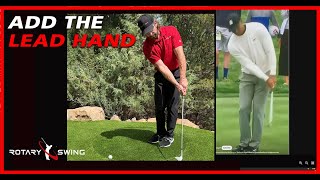

















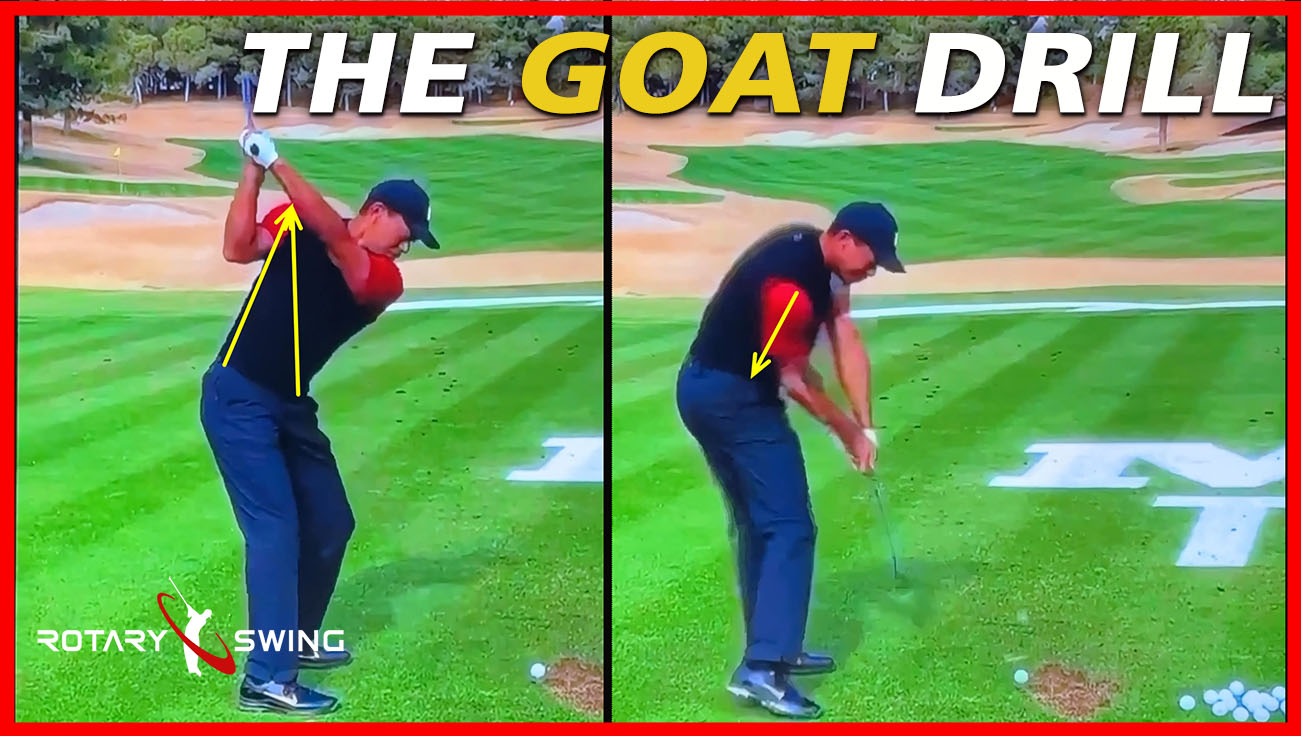


















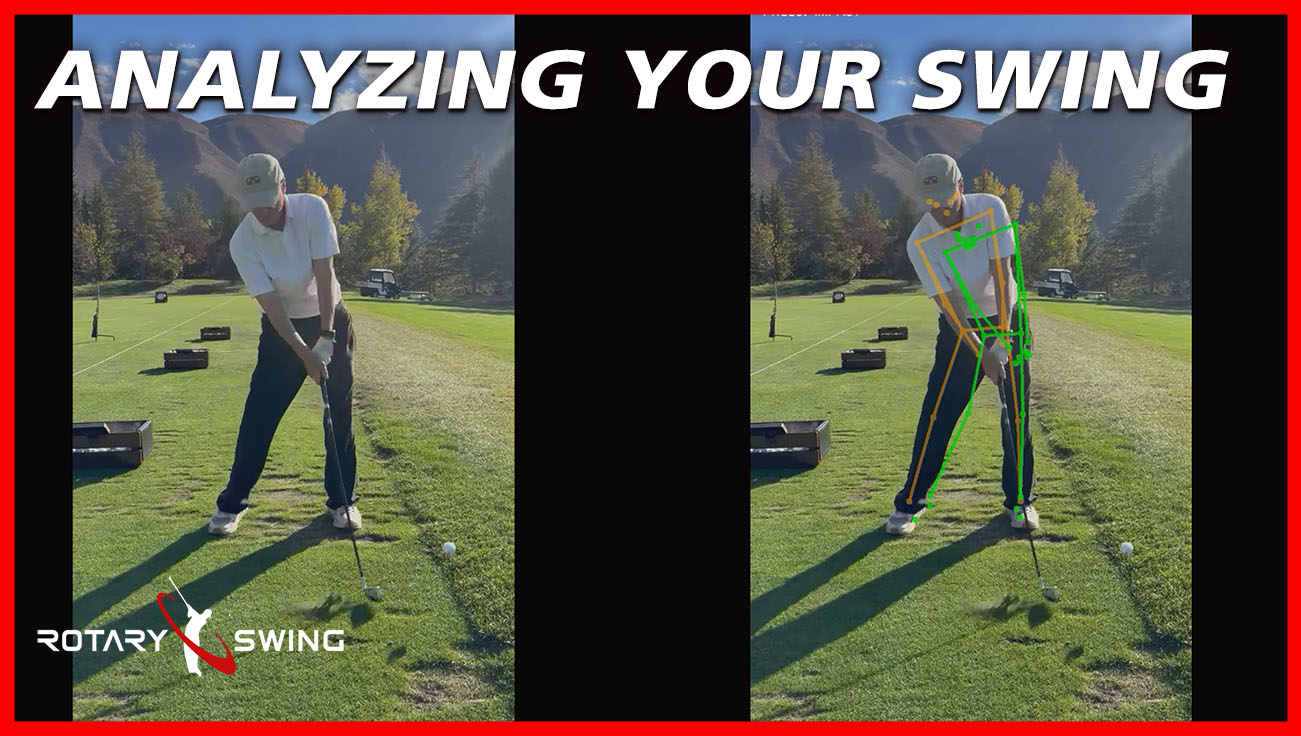








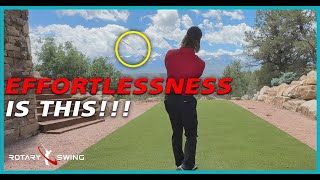
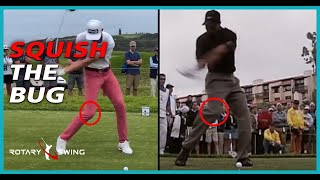











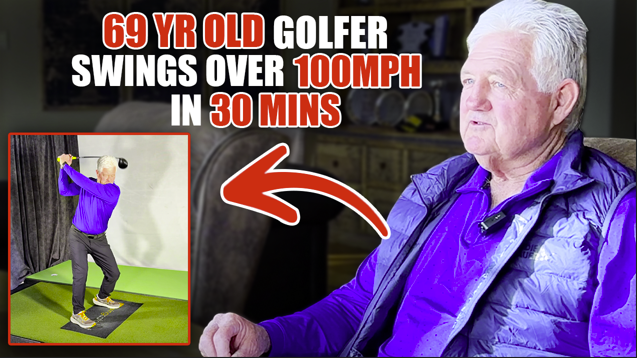

















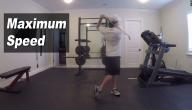

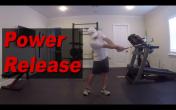

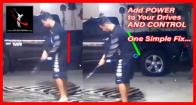
















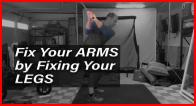










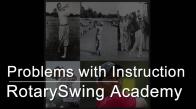








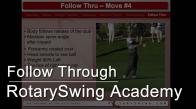















































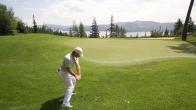





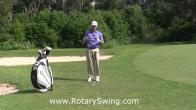













 View of both golf swings at the top of the backswing.
View of both golf swings at the top of the backswing. As the swing nears impact, there should be an approximate 90 degree angle between the club shaft and right forearm as the hands move in front of the right thigh.
As the swing nears impact, there should be an approximate 90 degree angle between the club shaft and right forearm as the hands move in front of the right thigh. At impact, the golfer should have the left shoulder over the left ankle and the hands leading the clubhead.
At impact, the golfer should have the left shoulder over the left ankle and the hands leading the clubhead. Tiger Woods & Chuck Quinton
Tiger Woods & Chuck Quinton Setup - Left ear on the ball
Setup - Left ear on the ball Tiger's stance is about 2" outside neutral - Chuck's is too wide for his hip size
Tiger's stance is about 2" outside neutral - Chuck's is too wide for his hip size Comparing the takeaway
Comparing the takeaway Comparing shoulder turn - also note straight left leg
Comparing shoulder turn - also note straight left leg Chuck's leg is straight - the red line shows what left side breakdown would look like
Chuck's leg is straight - the red line shows what left side breakdown would look like Right shoulders are beginning to be visible behind the heads
Right shoulders are beginning to be visible behind the heads Tiger is stacked over the left side. Chuck is a little shy of neutral
Tiger is stacked over the left side. Chuck is a little shy of neutral Chuck hasn't shifted enough
Chuck hasn't shifted enough Comparing lag when shaft is vertical
Comparing lag when shaft is vertical Chuck still has good lag
Chuck still has good lag Checking the angles as the hands reach the right thigh
Checking the angles as the hands reach the right thigh Comparing shoulder angle
Comparing shoulder angle Checking hand position relative to the chest
Checking hand position relative to the chest Right wrist is still hinged
Right wrist is still hinged Hands are a little too far in front
Hands are a little too far in front Joints are aligned
Joints are aligned Impact
Impact Release
Release Follow through
Follow through
